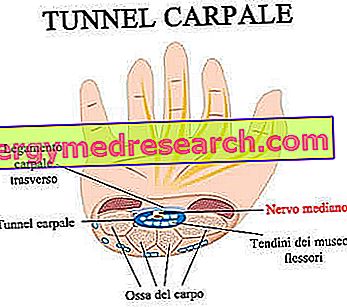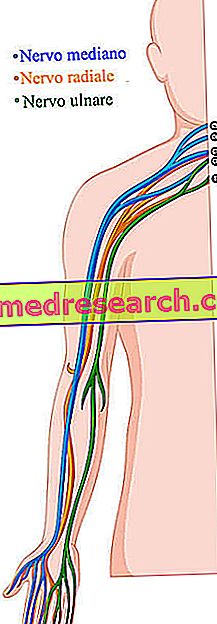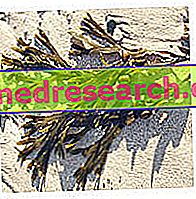Generality
The carpal tunnel is a narrow anatomical canal, located on the palmar side of the wrist, through which tendons pass through as many as 9 hand muscles and a very important nerve, known as the median nerve.

The 9 tendons that cross the carpal tunnel belong: one to the long flexor muscle of the thumb, 4 to the deep flexor muscles of the fingers of the hand and another 4 to the superficial flexor muscles of the fingers of the hand.
The median nerve is one of the most important nerves in the upper limbs. It takes its origin from the brachial plexus, approximately at the level of the axilla, and, from here, it first covers the whole arm and then the whole forearm, until it enters the hand.
From the medical-clinical point of view, the carpal tunnel is famous for being the protagonist of a famous nervous compression syndrome: carpal tunnel syndrome.
Brief anatomical reference to the wrist and the bones of the carpus
The wrist is the anatomical region that resides at the end of the distal end of the forearm and which represents the proximal portion of the hand .
The skeletal structure of the wrist is called carpus and includes 8 irregular bones, arranged in two rows of 4, which anatomists call carpal bones or carpus bones .
The carpus takes part in two joints: the wrist joint and the carpal-metacarpal joints .
The wrist joint is the result of the interaction between the carpus and the radius . The radius, together with the ulna, constitutes the skeleton of the forearm.
The carpal-metacarpal joints, on the other hand, are the result of the interaction between the carpal bones and the metacarpals . The metacarpals, or metacarpal bones, are the 5 parallel bones preceding the proximal phalanges of the hand ; the proximal phalanges of the hand are the first bony elements constituting the fingers of the hand.
| Carpus bones: | |
Proximal row, that is the row closest to the radius | scaphoid lunate triquetrum pisiform |
Distal row, ie the row closest to the metacarpal bones | Keystone trapezoid happened uncinato |
What is the carpal tunnel?
The carpal tunnel is the narrow channel that resides on the palmar side of the wrist, exactly where the forearm ends and the hand begins.
The carpal tunnel is anatomically important, because several tendons and a very important nerve, called the median nerve, pass through it.
A tendon is a band of fibrous connective tissue, which connects a muscle to a bone element.
A nerve, on the other hand, is a bundle of axons . An axon is the characteristic cellular prolongation of neurons, or nerve cells. The task of the axons is to spread the nerve signals.
Anatomy
The carpus forms a convex bone structure on the dorsal side of the hand and concave on the palmar side.
The palmar concavity, deriving from the particular anatomy of the carpus, is called the carpal arch .
At the base of the carpal arch, a large band of fibrous connective tissue develops, called the transverse carpal ligament .
The empty space delimited by the palmar arch and the transverse carpal ligament is the carpal tunnel.
CARPALE TRANSVERSE BINDING
A ligament is a band of fibrous connective tissue, which connects two bones or two parts of the same bone.
The transverse carpal ligament, also known as the flexor retinaculum, is a long and wide ligament, which runs along the entire wrist, from the radial side to the ulnar side. On the radial side, it finds insertion at the level of the carpal bones known as scaphoid and trapezius ; on the ulnar side, however, it engages at the level of the pisiform and hooked carpal bones.

THROUGH STRUCTURES FOR THE CARPAL TUNNEL: THE TENDONS
The tendons that through the carpal tunnel are exactly 9: the tendon of the long flexor of the thumb, the 4 tendons of the deep flexors of the fingers and the 4 tendons of the superficial flexors of the fingers.
- The tendon of the long flexor of the thumb . The long flexor of the thumb is the muscle that allows the flexion movement of the thumb. This muscle is born at the level of the radium, precisely in the radial tuberosity, and ends at the level of the second phalanx of the thumb, precisely with the so-called tendon of the long flexor of the thumb;
- The 4 tendons of the deep flexors of the fingers . The deep flexors of the fingers of the hand are the muscles that allow the flexion movement of all the fingers of the hand, except the thumb. These 4 muscles arise, mainly, at the level of the ulna and end, each one, at the level of the distal phalanges of the index, middle, ring and little fingers, with obviously the 4 tendons of the deep flexors of the fingers;

Around the tendon of the long flexor of the thumb there is a synovial sheath, which protects the aforementioned tendon structure from friction and rubbing. Another synovial sheath, with the same physiological role as the previous one, encloses the 4 tendons of the deep flexors of the fingers and the 4 tendons of the superficial flexors of the fingers.
It is possible that some readers have also heard another tendon in relation to the carpal tunnel: the so-called tendon of the radial flexor carpus muscle . It should be pointed out that this tendon does not cross the carpal tunnel properly, but passes through the transverse carpal ligament; therefore it is incorrect to include it in the list of tendons passing through the carpal tunnel.
The long flexor of the thumb and the 8 flexors of the fingers (the 4 deep and 4 superficial) are classifiable to the voice extrinsic muscles of the hand .
For extrinsic muscles of the hand, the anatomists understand all those muscles of the hand, one end of which lies outside the hand, in the specific case either in the forearm and in the arm.
THROUGH STRUCTURES FOR THE CARPAL TUNNEL: MEDIAN NERVE
The median nerve originates approximately in correspondence of the armpit, it flows along the whole upper limb and, passing through the carpal tunnel at the level of the wrist, it reaches the palm and all the fingers of the hand (excluding the little finger).
The median nerve possesses both a sensitive function - as it guarantees the tactile capacity of the palm of the hand - and a motor function - as it allows the movement of the thumb, index, middle and part of the ring finger.
With the help of the figure below, the reader can see that the median nerve passes through the carpal tunnel just behind the transverse carpal ligament and between the tendon of the long flexor of the thumb and the complex of the 8 tendons of the flexors of the fingers.
Function
The function of the carpal tunnel is to give the right passage to the 9 aforementioned tendons and to the median nerve.
Associated pathologies
Carpal tunnel is known to most people because it is the site of an important medical condition called carpal tunnel syndrome .
DEFINITION OF TUNNEL CARPAL SYNDROME AND SYMPTOMS
Carpal tunnel syndrome is the set of symptoms that arises following compression of the median nerve, produced by the bony and ligamentous structures of the carpal tunnel.
Carpal tunnel syndrome belongs to the category of so-called nerve compression syndromes . A nerve compression syndrome is a very particular condition, in which a nerve, crushed by the surrounding tissues, becomes irritated and loses some of its functions.
Carpal tunnel syndrome is responsible for:
- Pain in the wrist, in the palm of the hand and in the fingers controlled by the median nerve (therefore thumb, index, middle and part of the ring finger);
- Tingling in the hand. The affected areas are generally the anatomical regions covered by the median nerve;
- Sense of numbness . As in the previous case, the affected areas are usually the anatomical regions innervated by the median nerve.
Generally, the aforementioned symptoms appear gradually - their sudden appearance is unlikely - and tend to worsen in two situations: during the night and during manual activities involving wrist movement.
Less common symptoms of carpal tunnel syndrome:
- Dull pain in the arm and forearm;
- Paresthesia of the affected limb;
- Dry skin and skin color changes;
- Swelling;
- Hypoaesthesia;
- Difficulty to bend the thumb;
- Weakening of the muscles (atrophy), which govern the movement of the thumb;
- Difficulty in gripping objects and using a sore hand for activities such as writing or typing text on the computer.
CAUSES
The observation of many clinical cases has led doctors to suspect that the onset of carpal tunnel syndrome may depend on certain specific circumstances, such as:
- The presence, from birth, of a particularly narrow carpal tunnel. It should be pointed out that not all people with a very tight wrist develop carpal tunnel syndrome;
- The female sex. Statistics in hand, carpal tunnel syndrome is a condition that affects women more frequently. The reasons why the female population is more affected than the male population are unknown;
- A familiar predisposition to the problem in question. Some researchers have noted that, in certain families, carpal tunnel syndrome is a recurrent disorder, transmitted from generation to generation. The hypothesis that carpal tunnel syndrome would have a hereditary basis in some patients is to be investigated further;
- The presence of particular pathologies, including diabetes, rheumatoid arthritis, gout, obesity, chronic water retention, renal failure and hypothyroidism;
- Wrist injuries or injuries. If of a certain intensity, traumas and injuries to the wrist could alter the anatomical structure of the carpal tunnel. A structural alteration of the carpal tunnel is inevitably responsible for a modification of the space within which the 9 tendons described above and the median nerve pass. A modification of the space through which the median nerve passes could be the cause of a compression against the latter;
- The state of pregnancy. For reasons not yet clarified (perhaps it is water retention typical of pregnancy?), The incidence of carpal tunnel syndrome among pregnant women is very high;
- The repetitive and incessant practice of particular manual work / activities. Although there is currently no scientific evidence for this, it seems that, in some individuals, the prolonged repetition of certain hand movements or certain manual work is responsible for microtrauma on the wrist and a compression of the median nerve, by the carpal tunnel .
Among the activities / manual works that would seem to favor the carpal tunnel syndrome, it is worth mentioning, for the debate they provoke, playing a musical instrument, using vibrating working tools (chainsaw, jackhammer, etc.) and writing on the computer for many hours a day.
DIAGNOSIS
In general, a thorough physical examination and meticulous medical history are sufficient to diagnose carpal tunnel syndrome. The use of more specific and more complex diagnostic procedures (eg electromyography or the study of nerve conduction) occurs only in the presence of uncertain cases.
THERAPY
The treatment of carpal tunnel syndrome depends on the severity and on how the symptoms are (duration of symptoms). In fact, the therapy is conservative (or non-surgical), when the symptoms are moderate, bearable and in place for a few months; vice versa, it is surgical, when the clinical manifestations continue for more than 6 months and are so intense that they drastically affect daily life.
The conservative treatment of carpal tunnel syndrome includes a series of remedies, which are: resting the painful wrist, applying ice at the carpal tunnel, using a wrist brace and administering corticosteroids by way of oral or local injection.
As far as surgical treatment is concerned, this consists of an operation aimed at decompressing the median nerve. Surgeons can perform this operation in two alternative ways: through a classical surgery (also called "open") or by arthroscopy surgery. According to Anglo-Saxon statistics, more than half of those undergoing surgery, for the resolution of carpal tunnel syndrome, recover with satisfactory results.




